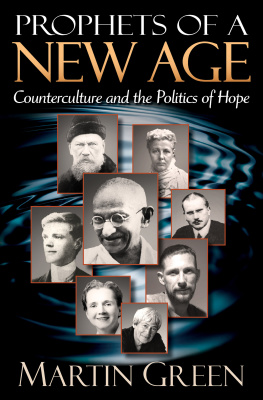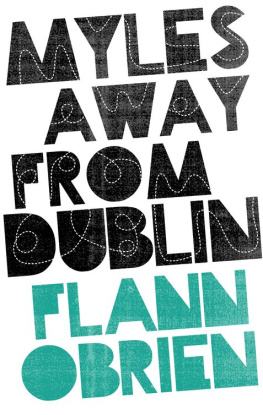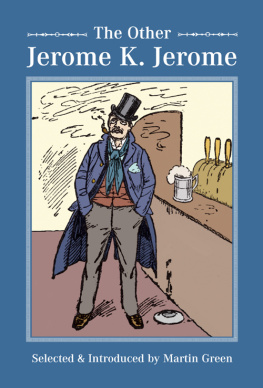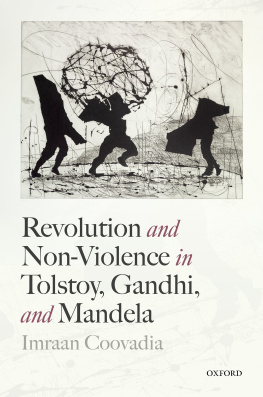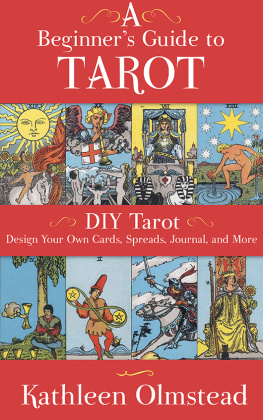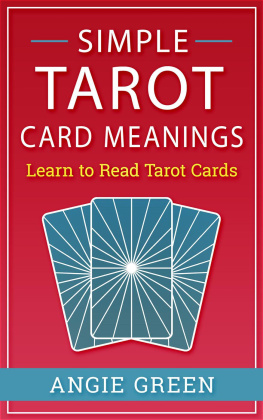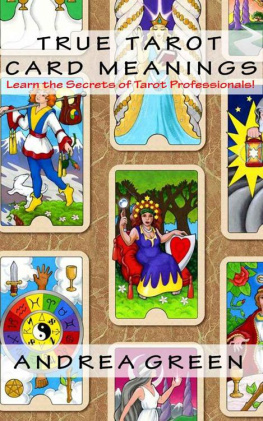Axios Press
PO Box 457
Edinburg, VA 22824
888.542.9467
Prophets of a New Age: Counterculture and the Politics of Hope 1992 by Martin Green. Cover photo of Ursula K. Le Guin copyright by Marian Wood Kolisch. All rights reserved. Printed in the United States of America. No part of this book may be used or reproduced in any manner whatsoever without written permission except in the case of brief quotations used in critical articles and reviews.
Ebook ISBN: 978-1-60419-093-9
Acknowledgments
Grateful acknowledgment is made for permission to reprint the following material:
Excerpt from The Return in Openings , copyright 1967 by Wendell Berry, reprinted by permission of Harcourt Brace Jovanovich, Inc.
Excerpt from The Mornings News from Farming: A Hand Book , copyright 1968 by Wendell Berry, reprinted by permission of Harcourt Brace Jovanovich, Inc.
Excerpt from The Mad Farmer Manifesto: The First Amendment IV in The Country of Marriage , copyright 1973 by Wendell Berry, reprinted by permission of Harcourt Brace Jovanovich, Inc.
Ballad of a Wilful Woman, from The Complete Poems of D. H. Lawrence by D. H. Lawrence, copyright 1964, 1971 by Angelo Ravagli and C. M. Weekley, Executors of the Estate of Frieda Lawrence Ravagli. Used by permission of Viking Penguin, a division of Penguin Books USA Inc.
Naming Gary by Ursula Le Guin. Used by permission of author.
At Yale from Provinces , copyright 1991 by Czeslaw Milosz Royalties, Inc. Published by The Ecco Press and reprinted by permission.
Excerpt from Revolution in the Revolution in the Revolution from Regarding Wave , copyright 1970 by Gary Snyder. Reprinted by permission of New Directions Publishing Corporation.
Excerpts from Spel Against Demons, The Call of the Wild, I went into the Maverick Bar, and Dusty Braces from Turtle Island , copyright 1974 by Gary Snyder. Reprinted by permission of New Directions Publishing Corporation.
Excerpts from Logging and Burning from Myths and Texts , copyright 1978 by Gary Snyder. Reprinted by permission of New Directions Publishing Corporation.
Excerpt from For All from Axe Handles , copyright 1983 by Gary Snyder. Published by North Point Press and reprinted by permission.
I t is a sign of the times that so many of us should be busy in studying the signs of the times. In no other age since the birth of Christianity has there been manifested the same devouring curiosity about the future, and the same disposition to expect a new earth, if not a new heaven.
A writer in the English journal The New Age , 1911
I t was the best of times, it was the worst of times, it was the age of wisdom, it was the age of foolishness, it was the epoch of belief, it was the epoch of incredulity, it was the season of Light, it was the season of Darkness, it was the spring of hope, it was the winter of despair, we had everything before us, we had nothing before us, we were all going direct to Heaven, we were all going direct the other way....
The eighteenth-century New Age, evoked by Charles Dickens, at the beginning of A Tale of Two Cities
Introduction
A Declaration of Provenance and Purpose
A lthough I strike a quasi-prophetic pose in writing this book, I know no better than anyone else what will happen at the turn of the century and the turn of the millennium. But I can show some striking similarities between our New Agers and their predecessors, between our situation in the 1990s and theirs in 1890 and 1790defining the New Age type each time as people who see radical degeneration going on around them, but also see the possibility of a radically new life for anyone courageous enough to embrace it.
Moreover, I can show that the 1890s was a crucial decade for the century that followed and that the 1790s was a crucial decade for the nineteenth century. Each century looks back to a New Age as its moral dowry and inheritance. No matter how whimsical or comical that New Age may seem in retrospect, it contains societys store of hope, even after the hope has been defeated as a practical proposition.
How many people today are living on their memories of the 1960s days of hope! (Even those who revile the sixties still find the topic absorbing.) Some sociologists are saying that it is since 1960 that in advanced industrial societies the postmaterialiststhose who live by a version of New Age ideashave grown to be a significant element. My starting point resembles that of those sociologists, though the course of my inquiry is quite different.
If the New Age efforts of the 1790s and the 1890s constituted a source of moral energy transmitted to the nineteenth and the twentieth centuries, then for our twenty-first century, our millennium, we have a need to build a New Age at least as strong as theirs. So a look at historical parallels may help us.
I shall also be declaring my sense of where, within our own New Age, we could profitably invest our energiesin whom we should invest our hope. There are in fact heroes and prophets among us, and even if the current venture in civilization cannot be saved, we can go out in style and in the best of company, if we choose. There is as much courage today, as much wit and will power, as much scope of mind and heart, as ever was to be found in the cultural treasury.
Finally, in thinking about this topic, I found myself distinguishing between three kinds of mind, or temperament, which jointly define my own position. One mind moves always toward power and possessiondeals in the lust for gold and blood and guts and grit, to use adventure language: there are politer power-language terms, like a hundred thousand a year plus expenses or briefing the Chiefs of Staff or smashing the opposition into a pulp. This is the voice of triumph and authority. We heard that language during the Gulf War (it is always heard in wartime) spoken by, for instance, General Schwartzkopf.
It was always clear to me that I belonged to a different type, with a different voice, whose social refuge is academia (in Christendoms past it was the Church). The mental temperament that flourishes there I call systematic. As far back as one looks there have been educators, priests, or shamans, preserving moral tradition, discriminating between legends, invoking valuessystematizing the images and the concepts. They constitute a kind of mind alternative to the authoritarian.
People of this second type find their way to that corner of the field which we call academia, or the clerisy, or the law, if they are lucky. There they mount their constant Cold War against the men of power, and win small battles in the minds of the young. But we (the men of law) wouldnt want to be too much at ease in Zion, too sure that the enemy are lost souls, for they have their own kind of virtue, and our self-complacency needs their challenge.
On another frontier, we meet a different moral challenge from a third type, the nave and enthusiastic mind that comes to expression in New Ages. People of this type (and we are all of this type part of the time) have a different sense of limits, and try things the others wouldnt dare. They affirm absolutes and realize ideals.
Those of us who belong to the second type must always measure ourselves against both the others, and seek out their virtue, to avoid a stupid pride in difference. Writers of books often belong to the second type. But then, so do most readers of books.
Culture as a whole, and each of us individually, is composed of elements of all three types. We discover this when we meet someone who goes further than we do in our own direction; for then we recoil in dismay, and begin to talk in a voice that is not our own. Meeting greater enthusiasts for New Age values than themselves, New Agers begin to sound cynical or rationalist; meeting a sterner specimen of their own type, authoritarians begin to assert their right to hope and their need to reason things out.

